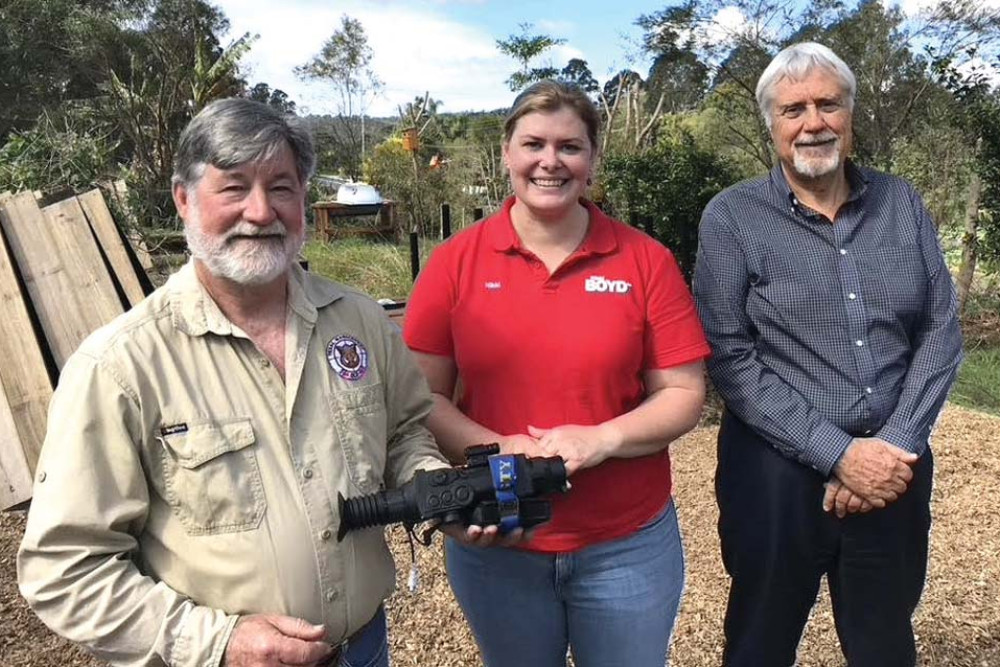Community & Business
23 March, 2024
Technology in fight against feral pests
IT would be hard to find an Atherton Tablelands landholder who has not been affected by feral pest animals.

Unfortunately, feral pest animals are widespread throughout the region, including dogs, pigs, cats, foxes, rabbits, goats and deer.
Feral pests inflict varying degrees of economic harm, from minor to severe including horrifically maiming and killing livestock and causing widespread livestock fatalities, while also posing a serious threat to people working on properties.
Feral Management Queensland (FMQ) is a dedicated volunteer, not-for-profit organisation, operating through regional hubs located throughout Queensland.
Its members provide feral pest eradication services to property owners all across Queensland.
“FMQ concentrates on the control and monitoring of feral pest animals using ground hunting, trapping, detector dogs, motion detection cameras, drones and the latest thermal night vision technology,” secretary Helen Poulos said.
“FMQ members who respond to feral pest threats are mature and experienced and operate under a strict code of conduct to ensure ethical hunting standards are practiced by all members of the organisation.
“They undergo extensive training and are required to demonstrate practical proof of marksmanship, navigation skills, radio procedures and use of global positioning system equipment to ensure safety in the field.
“Members operate under established standard operating procedures and are trained and equipped to operate safely and independently in the field.”
Helen said members were willing to undertake additional training for specific projects to comply with client protocols and procedures to form a good working partnership, a safe working environment, and achieve desired outcomes and measurable results.
“There is a marked difference in the effective reduction of feral numbers through culling by groups such as FMQ as opposed to recreational hunters who take only what they require as either a trophy or meat for their immediate needs,” she said.
“We have been successful in securing around $40,000 in the past two years which has enabled us to purchase equipment for safety on ground including defibrillator units, GPS with SOS functions, thermal monoculars for night work (especially feral cats), a satellite phone and vehicle first aid kits.”
Dogs which have gone feral are the most common pest animal on the Atherton Tablelands. Their prevalence is currently on the rise. There were 17 pest animals that were removed in the month of January which included dogs which had gone feral, feral pigs and feral cats.
“The dumping of domestic pets due to the cost of living crisis is also becoming a big problem,” Helen said.
“There is the possibility of large domestic dogs or lost pig dogs cross breeding with dogs which have gone feral. Now possessing hybrid vigor, the offspring can potentially be a larger and more dangerous animal.”
For many years, there were repeated sightings of a large Rottweiler which was running with a pack of wild dogs in the Millaa Millaa area.
“Feral pests often use the extensive land areas within protected areas or habitats to breed and take refuge, then migrate out onto adjacent grazing and agricultural land,” Helen said.
“When these ferals are pressured by farmers and other groups they retreat back into the safety of these areas.
“FMQ and similar groups can provide the resources to spend a week or two at a time to target specific areas of concern and provide ongoing support.
“A reduction of feral animals can be done via trapping, monitoring and ground shooting to provide a safer and more stable environment for native wildlife and their habitats.
“Ground-based removal of feral pests is very effective particularly given the recent access to the latest thermal night vision equipment.
“This work has been aimed at enabling native species to recover and thrive again.”
FMQ members have used GPS equipment in the field to aid the documentation and collection of valuable data for other agencies. This has involved collecting stomach contents and tissue samples to inform other agencies regarding numbers and types of native species being taken by feral pests and genetic makeup.
“We would be happy to work in conjunction with scientific agencies, they require our services,” Helen said.
Samples have also been used in the monitoring of potential disease outbreaks and spread.
“Our presence on the ground is another line of defence against the introduction and spread of zoonotic and other diseases which may be a threat to not only our native wildlife but to our domestic livestock industries as well,” she said.
This is especially important as feral pigs would have the potential to spread foot-and-mouth disease if it ever entered Australia.
Topaz property owner John Clarkson said he had been involved with FMQ for several years.
“FMQ has conducted wild pig control work on my property,” he said.
For further information on membership enquiries or how to utilise FMQ’s services contact, Helen on 0499 151 873 or Greg Prior (president) on 0419 913 536 or go to www.feralmanagementqueensland.org


